Nigel Williams / Polar Academy guide, Harvey Maps ambassador, Former Head of Training at Glenmore Lodge / Aviemore, Scotland
Nigel Williams has over four decades of winter mountaineering and polar experience with multiple trips to Greenland and the Himalayas. He currently supports the charity Polar Academy in delivering life-changing expeditions to young people. A sage on navigation and cold environments he offers his survival tips for polar expeditions, so we too can enjoy these spectacular environments, and look after ourselves to better care for others.
In 1888 the Norwegian explorer Fridtjof Nansen crossed the Greenland Ice Cap with 5 companions, it took them around 30 days. Their equipment was extremely basic; there were no dehydrated foods, down sleeping bags or sophisticated kits. Once they were over halfway there was no turning back, they had to get to the west coast or risk losing their lives. By contrast, thirty-three years later in 1921 Mallory and Irvine attempted Everest. This presented different challenges; cold being one. However, at any stage, they could choose to retreat down to base camp and safety within a day.
In the polar regions, we find perhaps the most challenging and remote environments on earth. This makes travelling and surviving in them both a testing and hugely rewarding experience. There is great beauty in these often barren landscapes. Preparation, routine and self-discipline are key to comfort and survival.
In this article:
- The Environment
- Terrain
- Fitness
- Equipment:
Clothing
Camping
The tent
Cooking, water and food
Digging tools
Sledges and packing - Hygiene
- Navigation
- Communication
Environment
Many Arctic regions are free of snow in summer. However, in winter the climate is cold and dry with temperatures often too low for rain. The wind is the real enemy, creating windchill which greatly exacerbates the effect of the cold and raises the risk of cold weather injuries. It is possible to get sunburn and snow blindness (sunburn of the retina) at the same time as frostbite even on cloudy days. Adequate protection for both eventualities is encouraged.
The natural shelter available is sparse. There is no vegetation and little wildlife except around the coasts. Survival depends on the resources you travel with; routine and discipline are key to everything you do. Between you and freezing to death is your clothing, tent, cooker, pot, fuel and means of creating a spark. All water comes from melting snow, and you need lots of it. This may seem uninviting.
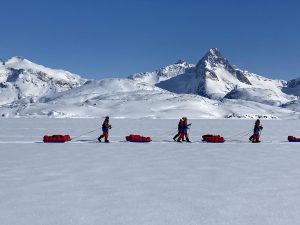
The good news is that on foot or skis with a sledge you can travel self-sufficiently for several months and cover vast distances. A 100kg sledge or ‘pulk’, is a heavy burden but on flat snow, it glides with relative ease. Pulling tyres around forest tracks and on beaches provides good preparation and often proves more arduous.
The Norwegians talk about the draw of the polar light which pulls those who have experienced it to return to these regions. There are stunning atmospheric phenomena such as whitebows instead of rainbows, the Aurora Borealis and sundogs (mock suns). The latter is known as parhelion (plural: parhelia) caused by the refraction of sunlight by ice crystals in the atmosphere. The hum of complete silence, the sculptured snow patterns and the glinting crystals can be utterly beguiling.

Terrain
The Polar climates reveal many different terrain challenges from blue ice to deep soft snow, hidden crevasses to sastrugi (windblown ribs of hard snow several feet high). There are also rivers with smooth ice sides and bottoms which disappear down deep holes under the ice known as ‘moulins’. With climate warming, increasing amounts of unmapped surface water are present and can be difficult to avoid without a drone. All these factors make any travel difficult and exhausting. Depending on the terrain and expected hazards; crevasse rescue, avalanche awareness and winter skills are essential pre-expedition training. In deep fresh snow or crevassed areas, it is a good idea to take off one ski at a time checking whether you can stand on the snow before taking the other off. Skis distribute weight over a larger area and removing them can lead to some surprises.


On the plus side, there are no creepy crawlies or spikey poisonous plants. Instead, we have penguins, polar bears, (not in the same hemisphere), curious seals, thieving arctic foxes, dive-bombing skewers, walrus, reindeer, musk ox and sled dogs. Keep your distance from the latter, they are not pets, and often live a pack life outside in all weather. Polar bears are by far the most dangerous hazard in the Arctic and they have been known to travel far inland if they get a scent. Some understanding of bear behaviour, tent positioning, carrying of appropriate weapons, a bear fence and training in these items is essential.


Fitness
Fitness is an important element of polar travel. We want to avoid over-exertion and resultant sweating which causes damp clothing. This creates considerable chill if cold temperatures seep in.
In addition, breathing heavily creates a build-up of ice around face coverings and facial hair including eyelashes. This can freeze zips and make clothing challenging to adjust. Goggles are essential. Adjustments to layering and level of exertion are two other ways to reduce this, but a good level of fitness will give the body an advantage.
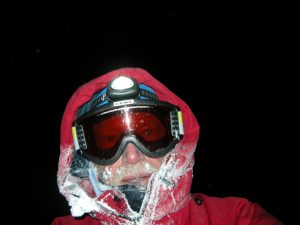
Equipment
Clothing
A key principle of clothing in the cold is that multiple thin layers of clothing are better than one thick layer. These trap more air to provide insulation which keeps us warm. As the climate is essentially dry, long windproof smocks rather than waterproofs are the preferred outer layer. These are usually heavy materials such as Ventile (a densely woven cotton) or “Paramo” type clothing. These are much warmer than typical breathable waterproofs for instance.
Down is the best insulator, a good long jacket and mittens are essential, whilst booties are great in the tent. Down trousers are only for the coldest conditions. If down becomes wet it loses its insulative properties. Any wet clothing can be hard to dry especially on overcast weather days, the garment will simply freeze and be unwearable.
Woollen underwear and thermals are the norm as they smell less and washing clothing is impractical. If wool is too scratchy against the skin then the thinnest silk or manmade wicking thermal under the wool works. Cotton holds moisture and is not advised as this will make the individual cold.
Feet naturally sweat; the inside of boots and socks in particular get damp which conducts cold. Vapour barrier socks are waterproof nylon bags styled as socks with a drawcord to stop them from loosening. They are usually worn between two layers of socks, a thin pair against the skin and the warm woollen one over the top. The thin pair will be wet at the end of the day but easy to dry. The outer pair and inside of the boot will be dry reducing cold conduction to the feet and limiting the risk of cold injuries.
Gloves and boots need to be a size or so larger than normal to cope with added layers. Tight-fitting clothing reduces blood flow to extremities and increases the risk of cold injury. Strap-on crampons for crossing large swathes of hard ice can have the same effect. Cross-country skis with only the toe of the boot attached enable feet to flex and generate warmth and blood flow. There are anecdotes of interesting frostbite issues for kite skiers due to a lack of foot movement in their more rigid foot bindings.
A good range of hats, gloves and mittens are required. Mittens are warmer than gloves as finger heat is shared. A pair of thin inner gloves are essential for doing more fiddly jobs and avoiding cold burns from touching metal. (Never try to melt anything frozen by licking it.) On a long trip, inner gloves get trashed so take more than one pair. It is normal to attach the outer mittens with a wrist loop so they can’t blow away in the wind if you remove them briefly. Gloves do not need to be expensive – ‘Chamonix bin men gloves’ are nicknamed for a reason, and rubber gardening gloves are good for handling ice blocks without dampening your mittens.
People often asked what is the most important piece of clothing. Everything you are wearing has a purpose but ski goggles are probably top of the list. If you are travelling into the wind with snow crystals blasting you in the face then you cannot open your eyes to carry out any task from navigating to erecting the tent. Goggles also prevent snow blindness which can be extremely painful and will prevent you and the team from travelling.
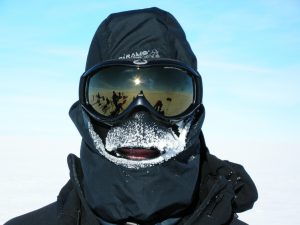
Camping equipment
A good sleeping mat is essential – these now come with insulation ratings and the best contain down. Do not blow air into them, your breath has moisture in it and that will freeze inside. Use either an inflation bag or a miniature rechargeable battery-powered pump.
Give the sleeping bag a good shake to puff it up, and do some rapid exercise before getting into it so your body warms the air in the bag. For a similar reason sleep in your thermals, and do not put on additional clothing as it prevents your body from warming the air between you and the down. Keep gloves, hats, boot insoles or inner boots in your sleeping bag. Your body heat is needed to keep these things warm and dry. Electronic devices lose battery life rapidly in cold weather and gas cylinders heat food slowly when cold – both these items can also go in the foot of your sleeping bag.
Rechargeable electronic devices are much better than carrying batteries. Head torches, solar inflatable tent lanterns, sleeping mat pumps, and GPS are all rechargeable. Solar chargers are variable but a powerpack the size of a mobile phone will last a couple of weeks. Solar chargeable inflatable lamps make a good tent addition.
The tent
A good tent will have a snow “Valance” or skirt to throw snow on to help anchor the tent. Big snow pegs are essential as they can be placed as a normal peg or horizontally in a slot in the snow with the guy rope clove-hitched around the middle. Skis also make good snow anchors but make sure the ski base faces the tent to avoid the guy lines being cut on the sharp ski edges. The very best tents come with large pole sleeves and two sets of poles. In bad weather doubling poles gives added strength and you have some backup if one pole does get broken.
Be sure to stamp the snow down in the area you intend to assemble the tent, or you will be in for a lumpy night.
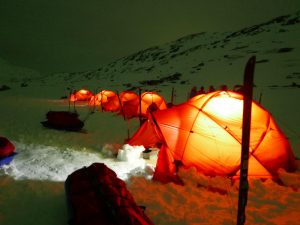
Cooking, water and food
Water is essential for life. Keep hydrated and always have extra water available. Roughly 5 pots of fresh snow will make one pot of water, the wetter or more icy the snow the better the ratio. Always start melting snow with a few centimetres of water in the bottom of the pot. A pot stuffed with dry snow is in danger of being damaged or even melting in the first minute. Once water is boiling a measuring jug is useful for scooping the water out, freeze-dried meals are the norm and you can get the water quantity right to avoid runny meals. The measuring jug can also be a spare mug if one breaks and can monitor how much liquid you are drinking.
1 litre “Nalgene” bottles make great hot water bottles and provide a good source of water for a first brew in the morning. 2x 500ml Nalgene bottles can fit in gloves, socks or boots to help dry or pre-warm them. Camelbaks and drinking tubes freeze, limiting hydration. A good combination is a 1-litre thermos, and one 1-litre and two 500ml Nalgene bottles. Nalgene bottles have a wide opening and are genuinely watertight so can be trusted in a sleeping bag. Some cheaper look-a-likes are not. Metal bottles tend to have small openings and are too hot to handle. If a lid does freeze just dip it in a pot of hot water. A Nalgene bottle filled with moderately hot drinking water at breakfast will retain some warmth throughout the day if wrapped in clothing in the sledge.
Depending on the distances travelled and weight carried, nutritional demand is likely to be high. Dehydrated meals are lighter to carry but high-energy snacks are often also needed to meet energy requirements. Be mindful of which snacks will freeze solid, making consumption difficult.
Expeditions tend to use petrol stoves such as the MSR GKX. Their base gets hot and will melt down into the snow until the pot falls off. Many sledges come with a wooden board which is very useful for placing the stove on and making a seat at the tent entrance. Do take a foam seat mat for insulation as well whether sitting or kneeling. Some trousers come with knee pads sewn in for insulation when kneeling.
It is advisable to hone your striker skills so you can make a good spark and familiarise yourself with your cooking equipment before setting out. This will benefit both you and your companions.
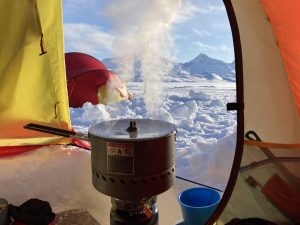
It is common to cook near the entrance of the tent, and in bad weather; in the porch. Keep the doors open to prevent carbon monoxide poisoning. As team medics, keep an index of suspicion for this illness. Anecdotally, cases have been missed at altitude where carbon monoxide poisoning has been misdiagnosed as altitude sickness. Cooking outside the tent is the safest option in fine conditions.
Make the tent area comfortable by digging out the porch down to knee height. This makes cooking, dressing and entering/exiting the tent much easier. A dishwashing brush is useful for brushing snow off boots and clothing before entering the tent.
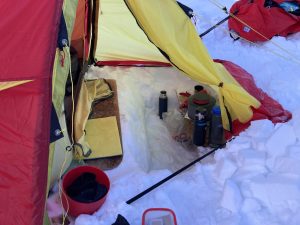
Digging tools
Two essential tools are a strong, long-handled shovel with a D-grip and a snow saw; better known as any good garden pruning saw (around £20). Avalanche snow saws cost 3 times as much and make no difference. Learn to cut really good square/oblong building blocks. It is a useful skill that takes time and effort to master. Building toilet shelters, windbreaks etc is all a part of winter expeditions and those two tools enable one to make a snow shelter. The layers of the snowpack can vary considerably in density and moisture content – not all snow makes good blocks. It is essential to make sure the foundation blocks are well-shaped and of the densest snow available, which may require digging and forming a “mine”. Cutting snow blocks from a mine for the toilet wall and tent windbreaks, well over 100 blocks can be required.
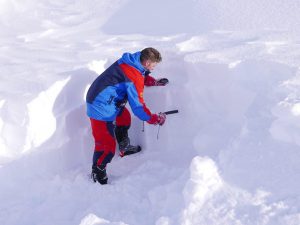
Sledges and packing
Sledges vary, North and South Pole trips will use glass fibre or carbon fibre ones that one could sleep in. Plastic sledges with a wooden board re-enforcement are fine for most other trips. A dry-line plastic polypropylene cord attached to a harness or even a rucksack works for pulling the sledge. However, it is important to have a piece of elastic bungee in the system to give a smooth pull as you stride along.
The real beauty of the sledge is that it has a large bag with a full-length zip and doesn’t need to be neatly packed. Organise your sled bag into areas to help personal admin in cold temperatures (when “faffing is fingers”). All food goes at the back end in a rucksack as this tends to be the heaviest item. The rubbish bag and the cooker (which can remain assembled to the fuel bottle) also go at the back. Spare clothing, sleeping bag etc. go in a large waterproof bag in the middle. Then the tent and sleeping mat (only half deflated to hasten re-inflation) are just thrown in on top (no packing, folding, or rolling). Lastly, anything for the day goes to the front. When stopping one can ski backwards with a foot on either side of the sledge until they can sit on it. You then unzip the front of the bag between your legs to access water, food, a warm jacket, and spare gloves. There is no need to take your skis off. The shovel goes on the outside of the bag. It is useful to carry a bum bag attached to the top of the sledge bag with a map, binoculars, sunscreen, glasses and GPS for quick access.
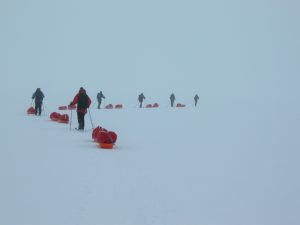
Hygiene
Personal hygiene is of course important, but wet wipes will freeze into a solid brick unless kept warm. Water-activated dry cloths, dipped into about 100ml of warm water in a small plastic sandwich box are effective. A small towel, toothpaste, 2 toothbrushes (a loss I’ve not forgotten) and anti-fungal powder are useful. Powdering feet at night helps to ensure you are reviewing your extremities for cold injury and encourages drying.
A 1-litre Nalgene bottle is ideal for a pee bottle, wrap a couple of turns of duct tape around it so you can identify it by feel. After using either empty it immediately under the tent fly sheet or keep it in the sleeping bag. Do not just leave it in the corner of the tent for the rest of the night. A litre of frozen urine adds a kilo of weight to drag and you can’t refill the bottle.
Navigation
Especially in a whiteout, navigation is extremely challenging. There are no reference points and it can feel like walking around inside a giant ping-pong ball. The lead person can struggle to maintain the optimal direction, meanwhile, the person at the back gets frustrated observing constant changes of direction. Using a GPS can be helpful but if the destination point in the GPS is set for several hundred Kilometres away, a deviation of 100m will not register. If there is some sunlight the position of your shadow works for maintaining direction although it changes position during the day. When skiing, a compass board to hold the compass and a watch can be helpful.

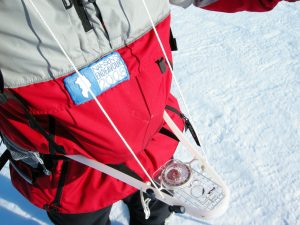
Communication
A satellite phone is essential for communication and allows a conversation if needed. However, these can be expensive. Spot devices are also available such as Garmin and as technology advances devices will become more sophisticated and accessible.
Summary
The Polar regions pose challenges and a need for resourcefulness and teamwork. Skis provide the only way to travel great distances under one’s own steam. For the prepared and forewarned these environments can be a winter wonderland. Silence, beauty and light provide ample time for reflection and for forming powerful memories that will stay a lifetime.
All images: Nigel Williams
The International Polar Guides Association IPGA produces guidelines on severe cold and wind management. These may be useful for further information: www.polarguides.org

















